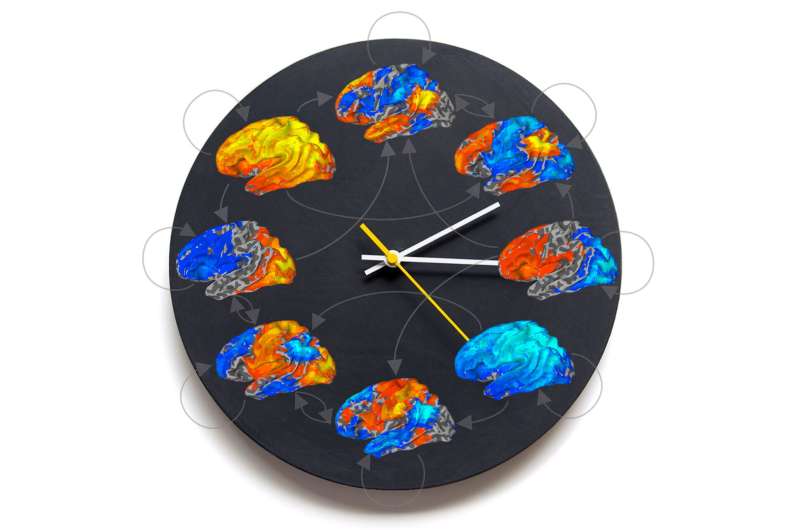Study reveals a delicate dance of dynamic changes in the conscious brain

Imagine you're at work: you're focused on a task when suddenly your mind starts to wander to thoughts of the weekend—that is, until you catch your boss walking by out of the corner of your eye. This back and forth in consciousness happens naturally and automatically and is the result of two brain states: the dorsal attention network (DAT), which corresponds with our awareness of the environment around us and the default-mode network (DMN), which corresponds with inward focus on ourselves.
Brain researchers consider these states to be anti-correlated, meaning when one is active, the other is suppressed. Michigan Medicine researchers studying consciousness have provided proof of this phenomenon using fMRI and illustrate, using a unique method, the ever-changing nature of the brain, even when under anesthesia or otherwise unresponsive.
Scientists have surmised that the DAT and DMN are higher-order brain functions associated with consciousness and that they are suppressed during unconscious states. But studies of these states have relied on methods that have been unable to definitively show that they are anti-correlated.
The research team, led by Zirui Huang, Ph.D. a research investigator in U-M Department of Anesthesiology, used common anesthetic drugs to see what happens to these two important brain networks. "We wanted to pinpoint which networks are related to consciousness," says Huang. "By suppressing consciousness, we developed a better sense of which networks are important for consciousness by process of elimination."
Most previous studies of these networks have relied on fMRI data averaged over several minutes.
"But we know the brain is changing second to second with different networks engaged in collaboration," says Anthony Hudetz, DMB, Ph.D., Professor of Anesthesiology and Director of the Center for Consciousness Science, and a senior author on the paper. "Temporal averaging can miss the actual dynamics of the brain and what underlies everything the brain does, from our thinking to our imagination."
The study team's approach, which took second by second images of brain activity, avoids a controversial processing technique called the global signal regression, which is used to reduce noise from fMRI data in most other studies of this type.
For their study, the team compared 98 participants who were awake, mildly sedated or generally anesthetized as well as patients with brain disorders of consciousness to analyze activity patterns in their brains from second to second. Using machine learning, they uncovered eight primary functional networks of brain activity: the aforementioned DAT and DMN, the frontoparietal network (involved in higher level processing), sensory and motor network (involved in sensation and movement), visual network (involved in sight), ventral attention network (involved in attention related to salient stimuli), and the global network of activation and deactivation (activity of the whole brain itself).
The team showed that the brain very quickly transitions from one network to another in regular patterns. The transition trajectories constitute a 'temporal circuit', where the conscious brain dynamically cycles through a structured pattern of states over time. In patients under sedation and in patients with brain disorders, transitions to the DAT and DMN, higher order brain functioning, was significantly reduced. They also found that the pattern of transitions among networks depends on how the subject was unconscious. "For example, under ketamine, besides the visual and ventral attention network, there is an increased number of transitions to the global activation and deactivation networks, which is related to psychiatric symptoms, like hallucinations," says Huang.
Most importantly, however, the anti-correlated DAT and DMN were essentially isolated from the temporal circuit of the networks when patients were unresponsive (and presumably unconscious) regardless of the path that got them there (drugs or an injury).
Huang hopes to next identify how the brain regulates these moment-to-moment changes from one network to another.
"We are providing a new picture of the brain, which changes dynamically through a temporal circuit. These structured patterns of brain changes are important for consciousness."
"Temporal circuit of macroscale dynamic brain activity supports human consciousness" has been published in Science Advances.
More information: Z. Huang el al., "Temporal circuit of macroscale dynamic brain activity supports human consciousness," Science Advances (2020). advances.sciencemag.org/content/6/11/eaaz0087

















